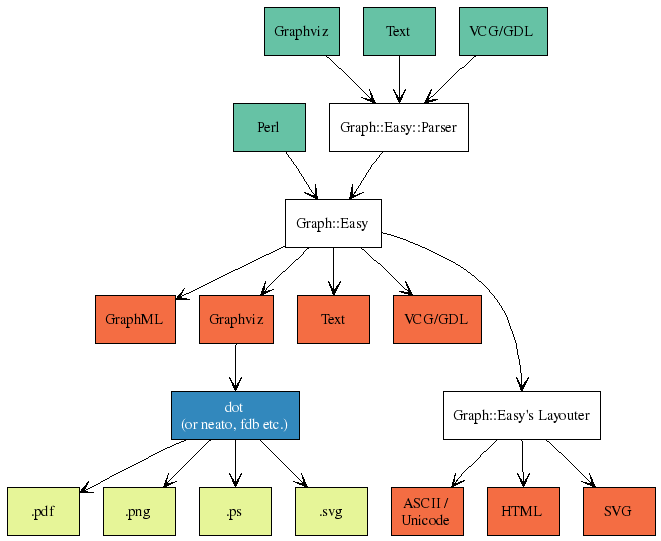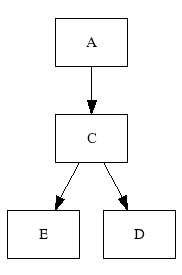Input and Output
Here is an overview of the data flow. Input is shown green, while direct output of Graph::Easy
is shown orange. The nodes in white are part of Graph::Easy.
Nodes in yellow show some possible output formats enabled via third-party
applications like 'dot'.

There are many ways to create the internal data necessary for
Graph::Easy to work with it:
- Use the interactive graph editor
- Write a text in one of the formats Graph::Easy understands (Graphviz, Graph::Easy, VCG, GDL) and use the command line utility graph-easy to parse, convert and layout it. (This script is installed as part of Graph::Easy.)
- Write Perl code (see below)
Here is a bit of example Perl code:
use strict;
use Graph::Easy;
my $graph = Graph::Easy->new();
$graph->add_edge('Bonn', 'Berlin');
$graph->add_edge('Berlin', 'Bonn', 'train' );
And here is the corrosponding textual description:
[ Berlin ] -- train --> [ Bonn ] [ Bonn ] --> [ Berlin ]
As you can see, the textual description is a bit shorter. Wether you want to convert your input data to text and then parse it, or convert it directly with Perl code is up to you, of course.
Likewise, once you have your data in an Graph::Easy object, you can output it in the
format you desire.
Note that the textual description format allows you a round-trip: you can feed
it to the Parser, and then generate text again from the resulting Graph::Easy object.
Storage vs. Layout
Graph::Easy did use the Graph module
to internally store and manage the graph data. Since v0.25, it no longer does so, instead
it stores the nodes/edges simply as Perl hashes and then accesses them directly.
If you want to know why, please ready this page.
Note that both the Graph and Graph::Easy modules do
only store a representation of the graph, but not a particular layout.
For instance the following graph (given in the Graph::Easy syntax, more on that below):
[ A ] -> [ C ] -> [ D ] [ C ] -> [ E ]
can be laid out in (probably infinitely) many ways. Here are two examples:

+---+ +---+ +---+
| A | --> | C | --> | D |
+---+ +---+ +---+
|
|
v
+---+
| E |
+---+
Layouts
To generate a specific layout, you need a module that provides this functionality. There are some possibilities for generating a layout from a graph via Perl:
- Graph::Easy
- dot (via graphviz)
- Graph-Layderer
- Graph-Layout-Aesthetic
There might be more - when I started with Graph::Easy, this were the options.
Unlike the others, Graph::Easy works on a checker-board tiled layout.
Note that the traditional way of placing the nodes anywhere does not enable you
to generate ASCII output, nor HTML. Well, it might be possible, but it is quite hard to
do when the edges don't run straight but all over the place :-)
That's one of the reasons for the existance of this project. :-P